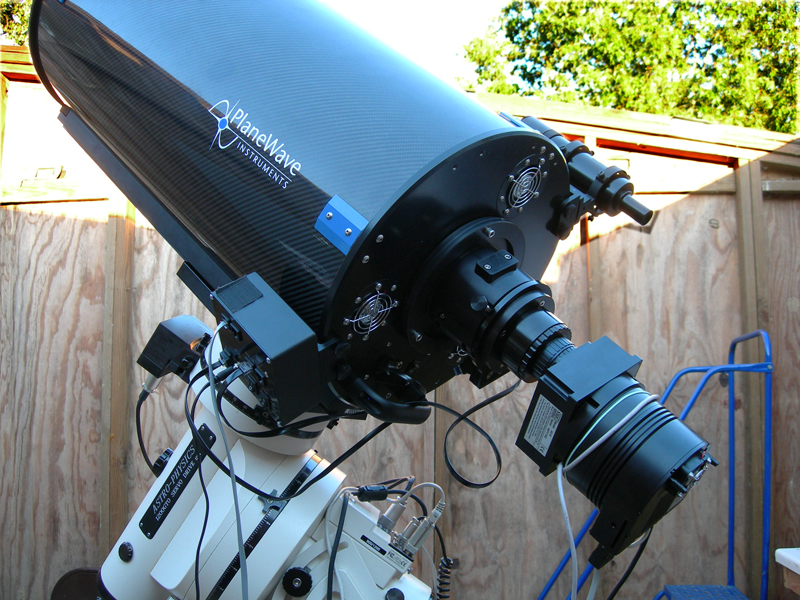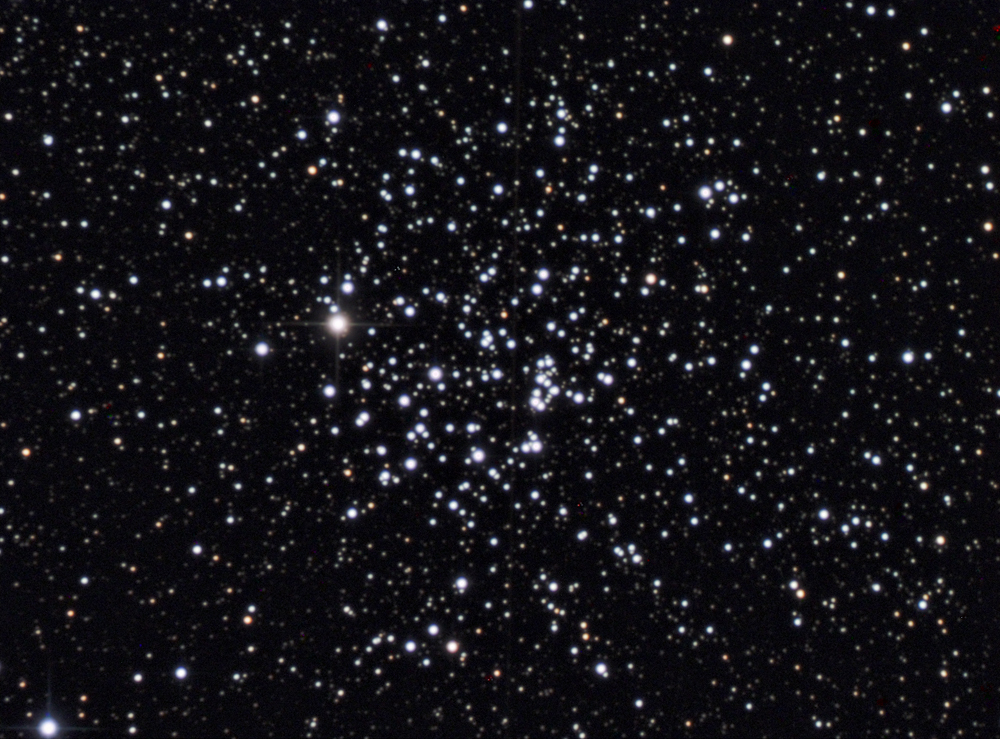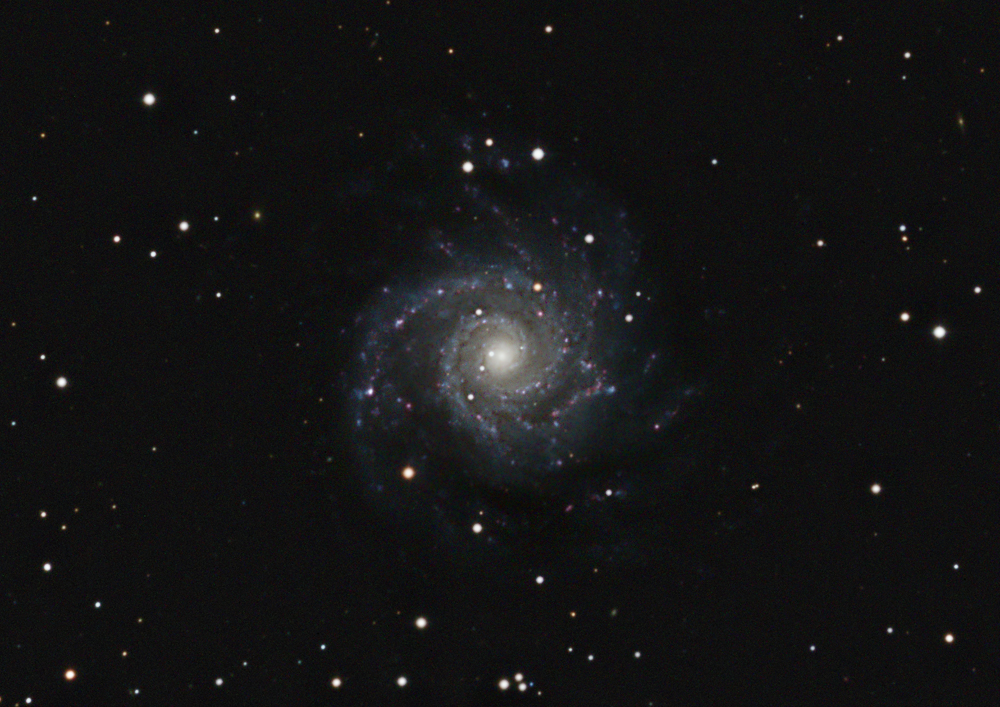|
|
 |
|
Planewave Instruments CDK 12.5 Telescope |
View showing visual back, EFA focuser control box, and SBIG ST-2000XM camera |
Planewave CDK 12.5-Astro-Physics 27TVPH Focal Reducer Testing
|
|
 |
|
Planewave Instruments CDK 12.5 Telescope |
View showing visual back, EFA focuser control box, and SBIG ST-2000XM camera |
I. Astro-Physics 27TVPH
Focal Reducer Testing:
The AP 27TVPH focal reducer
was tested on 12/12/2010 through 1/29/2011. This focal reducer may be useful in some cases
with SBIG ST-series cameras to help relieve severe image scale and provide a
slightly wider field of view. The reduction factor is not great at
0.78x. But this can still provide for better looking images on
small-chip cameras and help hide defects due to severe image scale, especially
when atmospherics are not the best. Below is a test frame of the open
cluster M52 from the Planewave CDK 12.5 with the focal reducer mounted in the
optical path. The focal reducer produced very acceptably round stars
edge-to-edge across the entire field with the ST-2000XM camera..
Note: no adaptive optics unit was used for
this first test as backfocus and spacing issues were still being worked out at
this point.
 |
Image Details:
II. Deep-Sky Test Image using the Astro-Physics 27TVPH
Focal Reducer with Planewave CDK 12.5 Astrograph:
 |
Image Details:
III. Parts
Matrix For Use With Astro-Physics 27TVPH Focal Reducer on Planewave CDK 12.5
OTA
(Parts are listed in the same order you would stack them onto the telescope's
back-end):
| Starting backfocus with Hedrick EFA Focuser | 182.88mm |
| Used backfocus (in mm): | |
| Planewave PN 125370 AP 2.7 inch Adapter | 12.70 |
| Astro-Physics AP27TVPH Focal Reducer (mounting collar backfocus) | 19.00 |
| 1 x 0.75 inch AP PN A3504-A spacer | 19.05 |
| RCOS PN T-2-AP, T-ring adapter for camera attachment | 7.62 |
| SBIG AO-8 Adaptive Optics* | 53.73 |
| SBIG CFW-10 Color Filter Wheel | 21.10 |
| ST-2000 Camera w/faceplate removed for CFW10 Color Filter Wheel* | 12.50 |
| Optical backfocus removed by focal reducer | 34.18 |
| Hedrick EFA Focuser position @ focus | 0.118 inches (~3.00 mm) |
| Telescope Native Backfocus and Focal Ratio With No Reducer | 2541mm (f/8) |
| Final focal length with reducer | 1971mm (f/6.2) |
| Focal Length Reduction | 0.78x |
| Image Circle Diameter of ST-2000 Camera | 15mm |
| Image Circle Diameter produced by telescope with focal reducer | 39mm |
| Metalback Spacing of Focal Reducer to Camera Chip in this Setup | 114mm (Optimal: 118mm) |
| Camera Rotation Method | Manual, by loosening focuser clamp ring |
*Note, the SBIG AO-8 adaptive optics unit can be used in this configuration by using the specific model of CFW-10 filter wheel with optical window to save backfocus on the camera and AO-8 attachment, instead of the version that uses its own standalone metal faceplate. With this specific telescope model and the small chip size of the ST-2000 camera, it can sometimes be critical for best results in typical seeing conditions to utilize both adaptive optics AND a focal reducer to minimize processing artifacts from the severe image scale.
IV. Conclusions:
The Astro-Physics AP27TVPH focal reducer is a very viable option for the Planewave CDK 12.5 astrograph that will work well with the SBIG "ST"-series of CCD cameras. This focal reducer offers the following attractive features:
1) Low-cost compared to the factory focal reducer.
2) Very forgiving of mis-spacing (with small-chip cameras), and long backfocus spacing to the camera chip. This long backfocus makes it easier to mount extra accessories in the payload such as adaptive optics. 118mm metalback spacing to chip is optimal, but with small-chip cameras I have used this reducer on other telescopes with camera chip spacing of as little as 94mm out to 137mnm with excellent results. With large-format cameras, this tolerance zone on chip spacing will be considerably less.
3) Rigid screw-down attachment to the camera and reducer-to-telescope. No clamping anywhere in the imaging payload using the Planewave focuser adapter to AP threads listed above in the parts matrix. This helps to prevent camera sag.
4) Availability of a large array of high-quality flex-free threaded Astro-Physics spacers and Optec AP spacer shim-rings to optimize camera chip spacing.
5) Excellent optical quality of the reducer lens element. The lens design of this focal reducer is totally "flat". It does not add or subtract any coma from the light-cone going through it. For telescopes like the Planewave that produce a very optically flat field to begin with, this focal reducer is an excellent option. It only reduces focal length with no other alterations to the light cone other than reducing the fully illuminated image circle by a factor of 0.78x. The reduction in fully-illuminated image circle size to approx 39mm diameter with the Planewave scope is a non-issue for the ST-2000 camera since its required light cone diameter for 100% non-vignetting is only 14.8mm. The optical coatings of the reducer glass are typical outstanding Astro-Physics quality. I have seen no problems at all with bright-star reflections or ghosting with this telescope and camera setup using the AP focal reducer with Custom Scientific LRGB filters.
Wade Van Arsdale
Page last updated February 5th, 2011
Little Rock, AR., USA